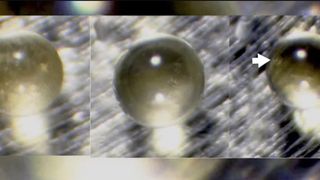China discovers strange glass beads on moon that may contain billions of tons of water
Scientists detected water trapped inside glass spherules on the moon after analyzing soil samples brought back by China's Chang'e-5 mission.

Chinese researchers may have discovered billions of tons of water inside strange glass spheres buried on the moon, and they could be used as a future water source for moon bases, a new study suggests.
The tiny glass spherules, collected in lunar soil samples and brought to Earth by China's Chang'e-5 mission in December 2020, could be so abundant that they store up to 330 billion tons (300 billion metric tons) of water across the moon's surface, the new analysis, published March 28 in the journal Nature Geoscience (opens in new tab), shows.
Related: China is hunting the world's most elusive particles a mile beneath the ocean floor
The glass spherules, also known as impact glasses or microtektites, form when meteorites smash into the moon at tens to hundreds of thousands of miles per hour, blasting chunks of lunar crust above the moon's surface. Inside these plumes, silicate minerals heated to molten temperatures by the force of the impact combine to form tiny glass beads that are sprinkled like crumbs over the surrounding landscape.
The moon's soil contains oxygen, which means that the beads do too. When struck with ionized hydrogen atoms (protons) from solar wind, the oxygen in the molten spheres reacts to form water that is sucked inside the silicate capsules. Over time, some of the spheres become buried beneath lunar dust particles, known as regolith, and are trapped underground with the water still inside.
At the right temperatures, some of these beads release the water into the moon's atmosphere and onto its surface, acting as a reservoir that is slowly refilled over time, the researchers said. This could make these spheres an ideal source of water, as well as hydrogen and oxygen, for space agencies like NASA and the China National Space Administration (CNSA) that want to build bases on the moon. The CSNSA expects its moon base project to be completed as soon as 2029.
"If we want to extract the water in impact glass beads for future lunar exploration, first we collect them, then boil them in an oven and cool the released water vapor. Finally, you will get some liquid water in a bottle," study co-author Sen Hu (opens in new tab), a planetary geologist at the Chinese Academy of Sciences' Institute of Geology and Geophysics, told Live Science in an email. "Another benefit is that impact glass beads are [common] in lunar soils, from equator to polar and from east to west, globally and evenly."
China's Chang'e 5 mission, named for a Chinese goddess of the moon, was the fifth in a series of missions that aim to lay the groundwork for future human landings on the moon's surface. The mission landed on the moon to scoop material from its surface before returning to Earth in December 2020.
Live Science newsletter
Stay up to date on the latest science news by signing up for our Essentials newsletter.

Ben Turner is a U.K. based staff writer at Live Science. He covers physics and astronomy, among other topics like tech and climate change. He graduated from University College London with a degree in particle physics before training as a journalist. When he's not writing, Ben enjoys reading literature, playing the guitar and embarrassing himself with chess.
-
Mensaforthementalmidget Absolutely astounding! H2O in little glass beads all over the moon that may (which also means may not) contain billions of tons of water!! And there's oxygen in the soil on the moon too!? I didn't know the moon has soil....I thought it was dust?Reply
The only thing that ruffles my space suit is that China discovered the wet glass balls first. You'd think that would be hard to miss when we walked on the moon back in the day, but congrats to human kind anyways.
The rumor buzzing around the worlds collective space agencies is that China is looking to immediately send rockets back into space heading for Mars. The CCP has good information that they may (or may not) have found balls made of kryptonite , which is a native element on Mars, full of Kool-Aid. Several trillion tons of the sweet stuff is what the earliest guesses coming out of China's space cadet academy have projected.
When asked what they've consider doing with the unbelievably unbelievable find: Sum Guy said they would make plans to bring the Kool-Aid back to earth so everyone can drink the Kool-Aid. That is of course only after we first drink that water sitting in all those glass balls on the moon!
Cheers! Oh Yeah! -
tomcole Reply
There is no way to confirm that all of the glass spherules have the same amounts of water in each one. Also, perhaps some are contaminated with who knows what. The Chinese will never get it home so no worry. What do they hope? Chinese will hold the key to all future water...baloney!admin said:Scientists detected water trapped inside glass spherules on the moon after analyzing soil samples brought back by China's Chang'e-5 mission.
China discovers strange glass beads on moon that may contain billions of tons of water : Read more -
SpaceCadet3223 To my knowledge there is no atmosphere (or soil) on the moon. Therefore liquid water could not exist there no matter what the temperature is. It would evaporate the moment it reached the surface. If the spherules really do contain water, it could be collected & extracted in a pressurized environment.Reply
Most Popular

By Harry Baker